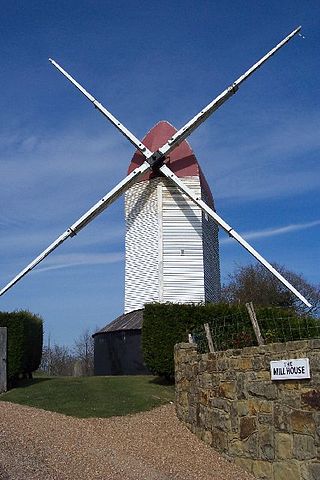
The post mill is the earliest type of European windmill. Its defining feature is that the whole body of the mill that houses the machinery is mounted on a single central vertical post. The vertical post is supported by four quarter bars. These are struts that steady the central post.

Pitstone Windmill is a Grade II* listed windmill in England. It is thought to have been built in the early 17th century, and stands in the northeastern corner of a large field near the parish boundary of Ivinghoe and Pitstone in Buckinghamshire. Presently, the windmill belongs to the National Trust.

Kibworth is an area of the Harborough district of Leicestershire, England, that contains two civil parishes: the villages of Kibworth Beauchamp and Kibworth Harcourt. At the 2011 census, Kibworth Beauchamp had a population of 5,433 and Kibworth Harcourt 990. The villages are roughly divided by the Midland Main Line. Kibworth is close to Foxton Locks, Market Harborough, and Leicester.

Durrington or High Salvington Windmill is a Grade II listed post mill in High Salvington, Sussex that has been restored and is in full working order. The mill stands 320 feet (98 m) above sea level and is able to take advantage of incoming sea winds.

Outwood Windmill is a Grade I listed post mill in Outwood, Surrey. Built in 1665 by Thomas Budgen, a miller from Nutfield in Surrey, it is Britain's oldest working windmill. It was one of a pair after 1797, alongside a smock mill that had the tallest smock tower in the United Kingdom until its collapse in 1960.

Thrigby Post Windmill is located in the civil parish of Mautby in the English county of Norfolk. The mill is on the south side of Mill Lane 1,125 yards (1.029 km) east of the village of Thrigby. The post mill is north of The River Bure, Breydon Water and the Halvergate Marshes.

Chillenden windmill is a grade II* listed open-trestle post mill north of Chillenden, Kent, England. It is the last post mill built in Kent.

Keston Windmill is a grade I listed Post mill in Keston, formerly in Kent and now in the London Borough of Bromley. The mill was built in 1716 and is conserved with its machinery intact but not in working order.

West Kingsdown Windmill is a Grade II listed smock mill in West Kingsdown, Kent, England, that was built in the early nineteenth century at Farningham and moved to West Kingsdown in 1880. It is the survivor of a pair of windmills.

New Mill is a Grade II* listed post mill at Cross in Hand near Heathfield, East Sussex, England. It was the last windmill working commercially by wind in Sussex, ceasing work by wind in 1969 when a stock broke.

Argos Hill Mill is a grade II* listed post mill at Argos Hill, Mayfield, East Sussex, England

Ashby's Mill, often referred to as Brixton Windmill, is a restored grade II* listed tower mill at Brixton in the London Borough of Lambeth. The mill was in Surrey when built and has been preserved.

Bragg's Mill, William Bragg's Mill, Bartlow Hamlet Mill or Stevington End Mill is a grade II listed post mill at Ashdon, Essex, England which has been restored.

Mountnessing Windmill is a grade II* listed post mill at Mountnessing, Essex, England. Built in 1807, it was most recently restored to working order in 1983.

Friston Windmill is a Grade II* listed post mill at Friston, Suffolk, England which has been conserved.

Holton Windmill is a Grade II listed post mill at Holton, Suffolk, England which has been preserved as a landmark.

Upthorpe Mill is a Grade II* listed post mill and scheduled monument at Stanton, Suffolk, England, which has been restored to working order.
Syleham Windmill was a Grade II listed post mill at Syleham, Suffolk, England which was built in 1730 at Wingfield and moved to Syleham in 1823. It was blown down on 16 October 1987. The remains of the mill survive today, comprising the roundhouse and trestle.

Cromer Windmill, restored in four stages between 1967 and 1998, is a Grade II* listed post mill at Cromer, Ardeley, Hertfordshire, England.

Bourn Windmill is an open trestle post mill at Bourn in Cambridgeshire, England, which was standing in 1636. It is a Grade I Listed building and a Scheduled Monument. It is the oldest surviving windmill in the United Kingdom. The mill ceased work commercially in 1927 and was preserved in 1932. In November 2021, it was placed on the Heritage at Risk Register as being in danger of collapse.





















